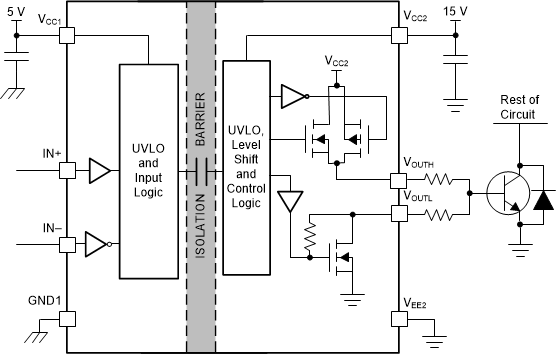TIDUE53I march 2018 – july 2023 TMS320F28P550SJ , TMS320F28P559SJ-Q1
- 1
- Description
- Resources
- Features
- Applications
- 6
- 1System Description
- 2System Overview
-
3Hardware, Software, Testing Requirements, and Test Results
- 3.1 Required Hardware and Software
- 3.2 Testing and Results
- 4Design Files
- 5Trademarks
- 6About the Authors
- 7Revision History
2.2.2 UCC5320
The UCC53x0 is a family of compact, single-channel, isolated IGBT, SiC, and MOSFET gate drivers with best-in-class isolation ratings and variants for pinout configuration, and drive strength.
The UCC53x0 is available in an 8-pin SOIC (DWV) package. This package has a creepage and clearance of 8.5 mm and can support isolation voltage up to 5 kVRMS, which is good for applications where reinforced isolation is needed. With these various options and wide power range, the UCC53x0 family is a good fit for motor drives and industrial power supplies.
- 3-V to 15-V input supply voltage
- 13.2-V to 33-V output driver supply voltage
- Feature options:
- Split outputs (UCC5320S and UCC5390S)
- UVLO with respect to MOSFET collector (UCC5320E and UCC5390E)
- Miller clamp option (UCC5310M and UCC5350M)
- Negative 5-V handling capability on input pins
- 60-ns (typical) propagation delay for UCC5320S, UCC5320E, and UCC5310M
- 100-kV/µs minimum CMTI
- Isolation surge withstand voltage: 4242 VPK
- Safety-related certifications:
- 4242-VPK isolation per DIN V VDE V 0884-10 and DIN EN 61010-1 (planned)
- 3000-VRMS isolation for 1 minute per UL 1577 (planned)
- CSA Component Acceptance Notice 5A, IEC 60950-1 and IEC 61010-1 End Equipment Standards (Planned)
- CQC Certification per GB4943.1-2011 (Planned)
- 4-kV ESD on all pins
- CMOS inputs
- 8-pin narrow body SOIC package
- Operating temperature: –40°C to +125°C ambient
 Figure 2-3 UCC5320 Functional Block Diagram (S Version)
Figure 2-3 UCC5320 Functional Block Diagram (S Version)